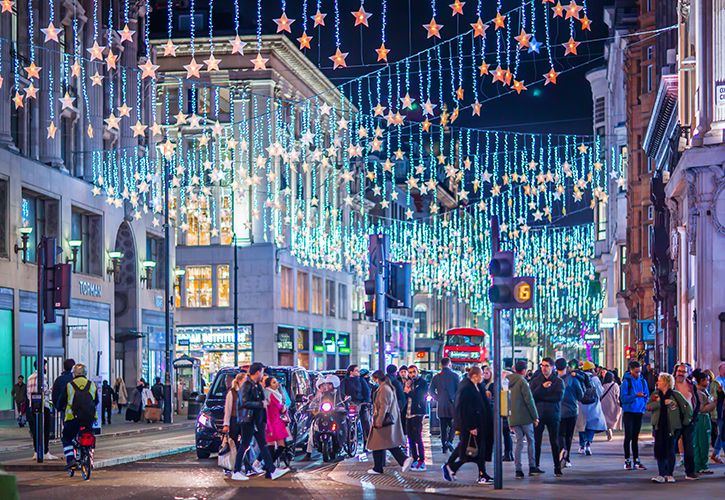UK DIY News
Shoppers To Spend More In Festive Sales Than Last Year

- UK consumers plan to spend £24 more than in 2022, with the average sales budget up 10 per cent year-on-year
- Four in five say the cost of living hasn’t impacted their sales budget, in an encouraging sign for retailers
- With many retailers deciding to give staff the day off this Boxing Day, over three quarters of shoppers will be searching for deals online instead
- One in three plans to browse reselling sites during the Christmas sales period, while one in six intends to list their unwanted Christmas presents
Festive sales shoppers intend to spend an average of £253 this year – 10 per cent more than in 2022 and the highest amount since before the pandemic – as they take advantage of early discounts and use reselling sites to find bargains.
New consumer research by Barclays1, which sees nearly half of the UK’s credit and debit card transactions, shows deal-seeking Brits will spend £24 more in the festive sales than they spent in 2022, with men set to spend £90 more than women on average (£299 vs £209).
Across the UK, those participating in the sales are expected to spend nearly £4.7 billion2 – £253 per head, which is £67 more than in 2019 and the highest figure for four years.
In an encouraging sign for retailers, 80 per cent of shoppers say the cost of living hasn’t impacted their budget. More than a third (34 per cent) cite the earlier start to the seasonal sales period as a motivator for spending, so as not to miss out on the best deals.
2023 sales budgets predicted to be highest in over four years | ||
Year | Average spend per person | Difference versus 2023 |
2023 | £253 |
|
2022 | £229 | -£24 |
2021 | £247 | -£6 |
2020 | £162 | -£91 |
2019 | £186 | -£67 |
This optimism is supported by the latest Barclays Consumer Spending Index, which showed that Brits’ confidence in their household finances (66 per cent) has reached its highest level since August (67 per cent), with retail spending up 2.5 per cent as early Christmas shoppers boosted the high street3.
Boxing Day behaviours
Boxing Day remains the most popular day to start festive sales shopping, with more than a quarter (27 per cent) beginning their search today. However, some bargain hunters said they were intending to begin on Christmas Eve (23 per cent) and even Christmas Day (17 per cent), due to retailers launching early discounts. Of those who planned to shop on Christmas Day, 16 per cent expected to do so during the King’s speech while one in 10 (11 per cent) planned to look for a bargain during Christmas dinner.
With many retailers closed on Boxing Day, more than three quarters (77 per cent) will do the majority of their festive sales shopping online: of this group, 37 per cent will browse from a smartphone, 27 per cent on a laptop or computer, and 13 per cent from a tablet. However, there are still many consumers who will spend more in-store (15 per cent), while 8 per cent will split the amount they spend evenly between the two.
However, shopping isn’t the only activity on the agenda this Boxing Day. Nearly half (47 per cent) are spending time with friends and family today; more than a third (36 per cent) are watching Christmas films and TV, and three in 10 (30 per cent) are going on group walks.
Clothes and accessories top sales wish lists
Fashion items such as clothes, shoes and accessories are the most sought after products amongst sales shoppers – appearing on one in three (34 per cent) wish lists, up slightly from 30 per cent last year. Skincare, beauty and make-up are also in high demand (23 per cent), rising from 15 per cent in 2022.
Meanwhile, appetite for food and drink (22 per cent) and tech products (19 per cent) has fallen by roughly half since last year.
Items | Christmas sales shopping list 2023 (%) | Christmas sales shopping list 2022 (%) | Year-on-year change (% points) |
Fashion e.g. clothes, shoes, accessories | 34 | 30 | +4 |
Beauty e.g. skincare, make-up | 23 | 15 | +8 |
Food and drink e.g. chocolates, wine | 22 | 41 | -19 |
Homeware e.g. furniture, cushions, kitchenware | 20 | 19 | +1 |
Personal technology e.g. smartphones, tablets | 19 | 42 | -23 |
Discounted Christmas-related items e.g. tree decorations | 18 | 13 | +5 |
Household technology e.g. TV, smart speakers | 15 | 32 | -17 |
Christmas goes full circle
To help budgets stretch further, 30 per cent are browsing second-hand sites to look for a festive bargain, with a savvy 37 per cent specifically searching for items described as ‘new with tags’ in the hope of finding unwanted Christmas presents at discount prices.
Meanwhile, one in six (16 per cent) will be listing their own unwanted Christmas presents on resale sites, increasing to 29 per cent among those aged 18-34. Unwanted clothes, shoes and accessories (30 per cent), children’s toys and games (15 per cent) and beauty products (14 per cent) are the items most likely to be listed. An organised one in eight (12 per cent) said they will be listing unwanted presents as soon as they received them on Christmas Day.
The most commonly cited reasons for selling unwanted Christmas presents are: to make some money quickly following an expensive Christmas (58 per cent), to capitalise on people selling unwanted gifts (38 per cent), or simply out of boredom (28 per cent).
Environmentally conscious Christmas shoppers
The environment is increasingly front of mind for many this year, with nearly half (47 per cent) making a conscious effort to buy fewer plastic-based goods in the festive sales.
A similar proportion (45 per cent) has also been trying to make more sustainable choices when shopping over the last 12 months, such as cutting back on over-ordering to avoid having to return unwanted items (42 per cent).
Two fifths (40 per cent) are making an effort to shop with local or smaller businesses in the Christmas sales, and nearly a third (32 per cent) are buying from retailers that they believe are making efforts to reduce their impact on the environment.
24-year-old Gemma, a second-hand shopping advocate, said: “I’ve been buying second-hand where possible for the last few years to reduce my impact on the environment and shop more sustainably. As Christmas rolled around, I made a conscious decision to buy nearly all of my presents for friends and family from pre-loved sites this year rather than buying brand new.
“They have all been really excited to open their presents, and it’s even encouraged some of them to follow suit when it comes to present buying in future. There’s not such a stigma for gifting second-hand anymore, and it means I save some money while the recipient often gets a better item than what I’d be able to afford brand new.”
Karen Johnson, Head of Retail at Barclays, said: “Retailers will be encouraged by a strong end to the year’s ‘golden quarter’. While Boxing Day remains the most popular day to start bargain-hunting, retailers are no longer putting all their eggs in one basket and are instead spreading out their discounts to boost ongoing demand – very similar to what we saw with early Back Friday deals in November.
“The earlier start means that some retailers will be in the fortunate position of having sold out of sales stock by early January, so we may see Spring products on shelves sooner than expected.
“This year’s finding also indicate a transformative shift in consumer priorities as shoppers look to treat themselves after Christmas. The emphasis on second-hand buying and selling reflects both a savvy approach to spending as well as a broader societal awareness of the need for more mindful consumption.”
Source : Barclays
Thank you for the excellent presentation that you gave at Woodbury Park on Thursday morning. It was very interesting and thought-provoking for our Retail members. The feedback has been excellent.











































